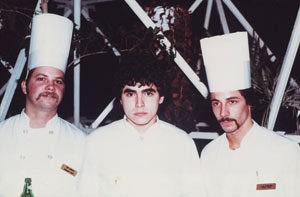Summerguide 2018 | view this story as a .pdf
Maine lobster stars for these celebrity chefs.
By Diane Hudson
 Once a humble bottom feeder fit only for the plates of prisoners and slaves, the Maine lobster is now hailed as haute cuisine. Today lobster is swimmingly approved by acclaimed chefs nationwide who spin it–like straw into gold–to ever-increasing culinary heights. A few of them share their favorite crustacean creations with Portland Monthly.
Once a humble bottom feeder fit only for the plates of prisoners and slaves, the Maine lobster is now hailed as haute cuisine. Today lobster is swimmingly approved by acclaimed chefs nationwide who spin it–like straw into gold–to ever-increasing culinary heights. A few of them share their favorite crustacean creations with Portland Monthly.
BAM!
Emeril Lagasse won a full scholarship to study music at the New England Conservatory of Music but turned it down
to pursue a life in the culinary arts. “My mother was the inspiration,” he says. “It all started in her kitchen.
I grew up cooking with her. I tried the music thing for a while, but in the end I wanted to cook.” That’s not to say he doesn’t feel the beat every now and then. “If there’s a set of drums at an event, it is likely that you will catch me playing before the night is over.”
From 1980 to 1982, Lagasse worked as the executive chef at the Sheraton in South Portland, where Doubletree is today. “Portland is a wonderful city with the ocean right there and great seafood,” he says. “I made a friend, Rod Mitchell [of Browne Trading Company], over 30 years ago, and I still buy Day Boat Scallops and Peekytoe crab from him.”
Asked if he ever thought about opening a restaurant in Maine, Emeril admits it’s crossed his mind. “I really loved being there,” he says. “There weren’t many restaurants back then, but there were fish shacks and lobster shacks. I had a home in Old Orchard Beach, and on the way to South Portland I would always stop at this place–I think it was called the Lobster Pot–for lobster rolls.” But Commander’s Palace in New Orleans drew him away in 1982, and the rest, as they say, is history.
Of the recipe he’s sharing with us–one of his go-tos–Emeril says it combines two of his favorite things: lobster and pasta. “It’s simple enough to let the taste of the sweet lobster shine through and yet sophisticated enough to serve as part of an elegant meal. When I opened Emeril’s in New Orleans (left), lobster wasn’t often seen on local menus. This was a way for me to introduce it to locals who already had a love for pasta with creamy seafood sauces. The touch of saffron adds complexity to the simple combination of flavors.”
Lobster & Pappardelle with Saffron Cream Sauce
Yield: 1 pound cooked lobster meat, about 2 cups chopped.
Prep Time: 1 hour
Total Time: 1 hour 35 minutes
1 pound fresh pappardelle pasta
2 tablespoons unsalted butter
2 tablespoons olive oil
2 tablespoons minced shallots
2 teaspoons minced garlic
1/4 cup dry white wine
1/2 teaspoon saffron threads
1 tablespoon tomato paste
1/2 cup Lobster Stock
1 cup heavy cream
2 1/2 cups teardrop tomatoes, cut in half
1 teaspoon kosher salt
1/2 teaspoon freshly ground black pepper
2 tablespoons unsalted butter
1 tablespoon chopped fresh chives
1 pound Steamed Lobster meat, chopped (recipe follows)
1/2 cup grated Parmigiano-Reggiano cheese
Bring a large pot of salted water to a boil. Add the pasta and cook until al dente, 3 to 4 minutes. Remove 1/2 cup pasta water from the pot and set aside; drain the pasta in a colander. Transfer the pasta to a bowl and toss with one tablespoon of olive oil, cover and set aside.
Meanwhile, heat the remaining 1 tablespoon of olive oil and 2 tablespoons of butter in a large skillet over medium heat. When hot, add the shallots and cook, stirring until soft and fragrant, about one minute. Add the garlic and continue to cook and stir for another minute. Add the white wine, saffron and tomato paste and cook for 5 minutes longer. Add the lobster stock and the reserved pasta water and bring to a boil. Cook until the stock is reduced by half, 5 to 7 minutes. Add the heavy cream and cook until reduced by half, about 5 minutes longer. Add the tomatoes, salt and pepper and reduce the heat to low. Cook just until the tomatoes release their liquid, about 3 minutes. Stir in the butter and chives and whisk to blend. Add the chopped lobster and cook until just heated through. Toss the pasta with the sauce and cook for 1 minute longer, until the pasta is heated through.
Divide the pasta between 4 bowls, garnish with the Parmesan cheese and serve immediately.
In a 6 quart cast iron Dutch oven, or other heavy-bottomed pot with a tight-fitting lid, combine the tomatoes, wine, water, sliced onions, peppercorns, tarragon, and bay leaf. Bring to a boil over high heat, reduce the heat to a simmer, and cook for 15 minutes.
Raise the heat back to high. Add the lobsters to the pot one at a time. Cover the pot immediately with a tight-fitting lid. Steam the lobster until they are bright red and you can pull the long feelers on the head out with no resistance, about 9 to 11 minutes. Using tongs, immediately plunge the lobsters into the bowl of ice water and let cool for 5 minutes. Repeat with the remaining lobsters.
Remove the lobsters from the ice water and set on a rimmed baking sheet. Using kitchen shears, remove the lobster meat from the tail and claws. Use a knife to chop the meat into bite size pieces. You should have about 2 cups of lobster meat, set aside until ready to use. Best if used within 2 days.
Rinse the lobster shells and reserve to make stock.
The Power of Two
Nominated five times for the James Beard Foundation’s Best Chef(s) of the Northeast award, the team of Clark Frasier and Mark Gaier got their start working for celebrity chef Jeremiah Tower. It was the mid ’80s and the two were working at Stars, Tower’s legendary restaurant in San Francisco. “J.T. was old-school–very difficult and rigorous,” says Frasier. “If he didn’t like what was prepared, he would throw it on the ground. He demanded–and got–the best.”
As if working under Tower wasn’t challenging enough, after two inspiring years at Stars, Frasier and Gaier decided they wanted to open a place of their own. “We were so young. No one would take a chance on us in California. It was so much money.” Turns out, California’s loss was Maine’s gain. In 1988, the two chefs opened the iconic Arrows Restaurant in Ogunquit, which went on to be selected as “One of America’s Most Romantic Restaurants” by Bon Appétit and “One of America’s Top 50 Restaurants” by Gourmet. Arrows closed in 2013 after 25 years, but the two James Beard award-winning chefs’ (the duo won “Best Chefs in the Northeast” in 2010) restaurant M.C. Perkins Cove is still cooking in Ogunquit.
In April, Frasier and Gaier cooked alongside their first boss again when Jeremiah Tower joined the pair at the renowned Pebble Beach Food & Wine weekend in California. The “premier epicurean lifestyle event on the West Coast” made for a perfect reunion. “It was so moving,” says Frasier. “It was like having the approval of your father or mother. When we worked at Stars we were kids. The world came to J.T. Every food writer and all the famous folks. Cooking with him as peers was very gratifying–everything came full circle. There was this feeling of real substance, which is an elusive fish these days.” But the real star of the event was none other than the Maine lobster in Frasier and Gaier’s Lobster Shortcake with Rum Vanilla Sauce.
Lobster Shortcake
with Rum Vanilla Sauce
Yield: 6 Servings
Shortcake:
1 1/2 cups all-purpose flour
1 1/2 teaspoons baking powder
1/2 teaspoon baking soda
1 teaspoon salt
12 tablespoons (1 1/2 sticks) very cold butter, cubed
3/4 to 1 cup buttermilk
1/4 cup heavy cream
Lime Vanilla Rum Sauce:
1/2 cup lime juice
1/2 cup rice wine vinegar
1/4 cup dark rum
1 serrano chile, seeded and finely chopped
1/2 vanilla bean, split lengthwise
1/4 cup finely chopped shallots
1 tablespoon finely sliced fresh ginger
1/2 pound (2 sticks) unsalted butter, softened
Kosher salt and freshly ground black pepper
Curried Shallots:
8 shallots, peeled and thinly sliced
1 teaspoon finely chopped fresh ginger
1 serrano chile, seeded and finely chopped
1 teaspoon turmeric
1 tablespoon Madras curry powder
1 teaspoon kosher salt
1 cup rice wine vinegar
Lobster:
3 (1 ¼-pound) lobsters, boiled and meat removed
1/2 pound (1 stick) butter
For the Shortcake:
Preheat the oven to 325°F. Combine the dry ingredients in a bowl. Cut the butter into the dry ingredients. Add the buttermilk, a bit at a time, until a soft dough holds together. Roll the dough to a 1/2-inch thickness and cut with a 3-inch round cutter. Make 12 cakes. Brush with cream and bake until lightly brown, about 15 minutes. Cool on a rack.
For the Lime Vanilla Sauce: Combine the lime juice, vinegar, rum, chile, vanilla bean, shallots, and ginger in a saucepan. Cook on medium heat until reduced by two-thirds. Reduce the heat to low and whisk in the softened butter. Season with salt and pepper to taste. Strain through a fine sieve and discard solid ingredients. The sauce can be held in a warm place for up to 1 hour.
For the Curried Shallots: Place all the ingredients in a stainless steel pot and bring to a boil. Turn on the heat and cool. These can be made a day ahead and kept in the refrigerator.
For the Lobster: Split each lobster tail in half. Melt the butter over medium heat.
Add the lobster and heat gently until the lobster is warmed through, 3 to 4 minutes.
To assemble the dish: Spoon half of the sauce evenly onto six warm plates. Split each shortcake and place the bottom half on each plate. Top each shortcake with one-half of a tail, a claw, and knuckle meat. Topped with the remaining sauce and then with the top of the shortcake. Divide the curried shallots among the plates.
Queen of the Coast
Primo chef/owner Melissa Kelly, the first two-time winner (1999, 2013) of the James Beard Foundation’s Best Chef: Northeast Award, came to the culinary table from an auspicious family background in Long Island, New York. “My mom was a stay-at-home mom who cooked a lot from food raised in her garden, because that was affordable,” she says. Another early role model was her Italian grandmother. “I loved to cook in her kitchen, and still prefer Mediterranean influences.” Her grandfather, Primo, was a butcher.
Granted a scholarship for studies at the Culinary Institute of America, Kelly graduated first in her class, and from there the experiences and accolades kept coming. “Working with Larry Forgione at American Place and Alice Waters at Chez Panisse really got me started on the path that was actually instilled by my grandmother: the best food is simple, seasonal, fresh, and uses only quality ingredients.”
What started in Rockland 19 years ago as “a small greenhouse, a few hens, and a couple of pigs” has become a four-acre organic farm providing 80 percent of what is served at Primo. The rest is sourced from local farmers sharing those same values.
Kelly also cooks and gardens at two other Primo locations. One is in Tucson, Arizona, and the other in Orlando, Florida, where she revels in the opportunity to grow and use different ingredients “like citrus, papayas, figs, and artichokes.”
For her own lobster-eating experience, Kelly loves going to McLoon’s Lobster Shack, a lobster pound run by a young couple. “[The owner’s] dad is a lobsterman. It’s in Spruce Head, ten minutes from the restaurant, and it’s BYOB.” Emeril would certainly join Kelly on this outing.
Maine Lobster
& Celeriac
Yield: 6 servings
2 whole Maine lobsters
1 tablespoon olive oil
1 tablespoon anatto seeds
1 medium onion, chopped
1 carrot, chopped
1 stalk of celery, chopped
2 cloves garlic, crushed
6 tablespoons tomato puree
1 cup brandy
½ cup sweet vermouth
1 bay leaf
1 sprig of thyme
¼ teaspoon cayenne pepper
6 cups lobster stock (can sub fish stock)
2 cups heavy cream
1 large knob celeriac, peeled and halved
(1 half diced in large chunks, 1 half sliced paper thin then julienne)
Salt and pepper to taste
Vegetable or canola oil
2 tablespoons parsley and tarragon, chopped
In a large sauce pot boil water and cook lobsters for 7 minutes. Remove and plunge into an ice bath. Pull lobster meat from shell reserving both the shells and the meat. Large dice meat and refrigerate until later.
Heat a large sauce pot over high heat.
Add lobster shells and annato seeds and sear.
Add onions, celery and carrot and cook until onion is translucent.
Add garlic and cook 3 minutes.
Add tomato puree cook 4-5 minutes but do not brown, deglaze with brandy and vermouth. Be careful as this may ignite.
Reduce the alcohol until almost dry, add spices and herbs, add stock. Add diced celeriac. Bring up to a boil, reduce by half. Make sure the celeriac is tender at this point.
Add heavy cream and bring it back
up to a boil.
Turn down to a simmer and cook 15-20 minutes longer.
Remove from heat and strain through a mesh strainer, pushing out all of the juices. Taste, adjust seasonings and check texture. If you’d like the sauce a little thicker you can put it back on the fire and thicken with a cornstarch slurry. (2 tablespoons cornstarch, 3 tablespoons cold water, mixed together and whisked in)
Heat vegetable oil to 375°.
Fry the julienne celeriac a handful at a time (it should be golden brown and crisp). Drain fried julienne on paper towels and sprinkle with salt.
When ready to serve heat sauce, add meat.
Garnish center of the plate with fried celeriac and chopped herb mixture.
In From The Windy City
Each summer, Chef Ryan McCaskey, the owner of Acadia, a Michelin Guide two-starred restaurant in the Windy City, returns to Deer Isle, his childhood playground where the cooking bug first bit. “When I was about eight years old, my family started summering in Maine at Goose Cove Lodge,” he says. “I would poke my head in the kitchen and study the chefs. Then one day, there I was, shelling peas.”
Following culinary studies in Chicago, McCaskey took a job cooking at Goose Cove, where he was spoiled with the freshest local ingredients. “We picked our own lettuce and herbs from our garden, got our chickens down the road, and went to the dock for fresh seafood.” Carrying this over to his own restaurant, McCaskey is insistent on getting his ingredients from Maine. “I get my lettuce from Maine’s Yellow Birch Farm in Deer Isle, and onions and potatoes from Four Seasons Farm in Harborside.” Unsurprisingly, McCaskey says he “can’t find blueberries anywhere better than Maine’s.”
But what lobster is he serving those Bear fans? “I only buy Stonington, Maine, lobster.” McCaskey tried Brittany Blue lobsters for awhile, but says they are expensive and hard to get. For a restaurant that goes through nearly 140 lobsters a week, they need those reliable Mainers.
While it’s clear this Chicagoan can crack claws with the rest of us, he prides himself on his bisque. “The lobster stock is made meticulously, using only certain parts of the crustacean,” says McCaskey. “Each step is strategic. We have mastered this at Acadia. It is a challenge teaching our chefs the technique. There’s a lot of push and pull. You have to be able to smell it, to taste it.”
Lobster Bisque
Yield: 3 quarts
1800 grams lobster bodies,
thorax only, gills removed
975 grams whole peeled tomato
788 grams carrots
375 grams onion
275 grams celery
100 grams garlic
175 grams leeks
110 grams tomato paste
250 grams cognac
28 grams chervil
3 grams bay leaves
Roast lobster, bay leaves, and garlic in a hot pan for 15 minutes. Add vegetables and continue to roast another 15 minutes. Deglaze with cognac and cook 5 minutes. Add tomato paste and chervil. Transfer to stock pot and add water just to cover. Cook for 2 to 2.5 hours. Chop or pulverize the solids and shells. Bring just to a boil. Strain. Reduce stock by half and add the same weight of the stock in heavy cream. Reduce by half again. Finish with whole butter and salt.
Rising Star
˝All I do is cook and study,” says 23-year-old Nathaniel Adam, executive sous chef at Boothbay Harbor Country Club and Harvest on the Harbor’s 2017 Lobster Chef of the Year. Self-taught, Adam has been cooking since he was a kid. “My mom was a single mom who worked all the time, so my older brother Eric and I cooked for the family.”
Adam’s brother went on to study at the College of Culinary Arts at Johnson & Wales University, and helped teach Adam the kitchen basics. “Only so much cooking is teachable. A huge portion of it is natural talent,” says Adam, who demonstrates plenty of that, winning Judge’s Choice at the sixth annual Claw Down Maine Lobster Bite Competition last year. For that recipe, he was trying to come up with the simplest way of using lobster “without masking the flavor.” He opted for “basic ingredients and a classic preparation to keep it elegant.”
When he isn’t buried in kitchen utensils or books for class, Adam loves to fish and hike in Maine with his fiancée. During Boothbay Harbor Country Club’s off-season, he runs Savor the Flavor, a private-chef service in Florida.
His go-to meal? “I’m a comfort-food kind of a guy. Give me a plate of ribs paired with some collard greens and cornbread–nothing beats it!”
Lobster in Its Habitat
Yield: About 1 quart
Sweet Corn Emulsion: 560 grams fresh sweet corn; 200 grams small diced yellow onion; 4 grams shaved garlic; 700 grams heavy cream; 10 grams salt; *166 grams thyme brown butter (last step)
Candied Thyme Brown Butter: 1 pound whole unsalted butter, 20 grams fresh thyme sprigs
Tarragon stock: 2 grams spent vanilla beans; 4 grams lemon zest; 10 grams minced garlic; 30 grams shallot; 70 grams fresh tarragon; 800 grams water; 15 grams white vinegar; 10 grams salt; 15 grams sugar; 2 tablespoons dry oregano
Vanilla Tarragon Sea Foam: 350 grams tarragon stock; 7 grams soy lethicin
Sea Salt Coral Tuile:10 grams flour; 80 grams water; 30 grams vegetable oil; 3 grams salt
Butter Poached Lobster Claws:6 lobster claws; 4 tablespoons whole butter; Pinch of salt; 1 tablespoon minced parsley
Place butter in a small pot and heat on low until melted. Place claws in pot and gently stir around to warm the lobster. Once lobster is warmed, season with salt and parsley.
Assembly: Serve as a large dish or in small spoons as an appetizer. Place corn sauce at the bottom of the spoon, top with the warm lobster, tobiko, a piece of tuile, a touch of sea foam and fresh herbs. Enjoy.





0 Comments